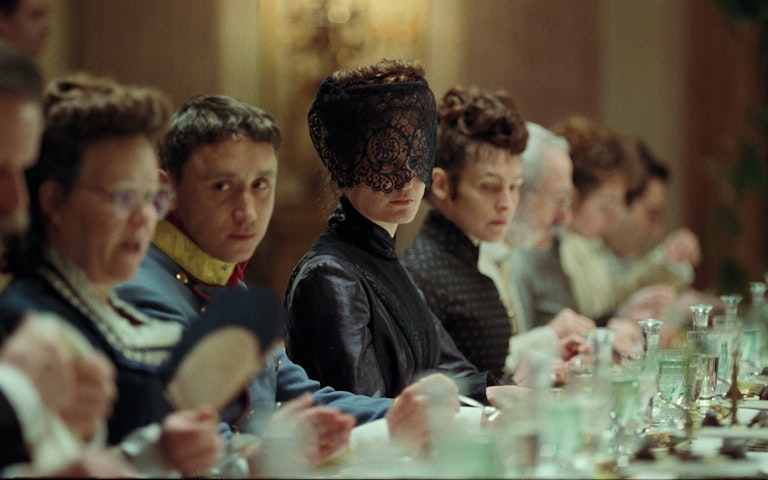Young Critics Review: Pacifiction

Pacifiction
Floating somewhere in the middle of Saint Jack (Peter Bogdanovich, 1979) and The Quiet American (Joseph L. Mankiewicz, 1958), Pacifiction finds Albert Serra filming the present for the first time in his career, ditching the 18th century France of his previous two features and venturing to Tahiti, where the French government official De Roller strains to get to the truth behind rumors of French nuclear testing being resumed in the area. Benoît Magimel as De Roller is the Ben Gazzara figure for this film’s version of French Polynesia, perversely depopulated due to lockdown restrictions during shooting, as he struts about in a white linen suit and slacks, a proprietary swagger both charming and egotistical. His relationship to the locals is always imbalanced, he is “of the island” but delights in his imagined position as benefactor. Their knowledge of his particular brand of possessiveness suffuses all conversations with a sense of silent deal-making, if only to humor his desire to keep up appearances. He fancies himself a man of action, but is well aware of his stark unimportance to the worldly events he will never be cut in on, and this gap is what prompts the absurdity of the strained investigation he commits himself to. As the progressive journalist in Conrad’s Nostromo quibbles, “Any government anywhere is a thing of exquisite comicality to a discerning mind”, and the film’s idea of neocolonialism is that of a mawkish diplomat being driven about the island to examine the expanse of the Pacific Ocean with a pair of tiny binoculars, an apocalyptic nuclear threat turning the irrelevant state representative into Jacques Clouseau.
Serra places a heavy emphasis on the exoticism of the film’s locale, the dreamlike images seen through a hazy eye with service workers replacing kitchen sinks amongst the lavish estates and intoxicating nightclub that are the center of social relations on the island. The nearly three-hour film moves with a languid rhythm, a sense of buoyancy when dealing with the sparse narrative and spending more time cultivating the seductive atmosphere. Pulsating neon lights and the persistent golden glint of the sun provide a sensory idea of paradise, at odds with the paranoiac temptations of De Roller’s escapades. Serra’s commitment to the film’s vibrations is his primary strength, but at times he can’t help indulging himself to the point where it is frustrating to see such a forceful visual imagination unable to prevent its own narcotized rambling.
"Pacificition’s hypnagogic qualities seem antithetical to the idea of the hangout film, but the beauty of Serra’s shooting technique is that while catching every interesting gesture, he never wastes a character."
The three-camera set-up he has used since Story of My Death (2013) excavates brilliant moments such as De Roller’s sly, sunglassed glance into the camera for a split second during a particularly braggadocious nightclub conversation. These privileged tics within performances are often elided in a classical shooting style, but prevent Serra’s films from moving between perspectives with conviction, marrying them to his meandering gaze. He is far from a moralist but has a tendency to underline his pet themes about liberty and the rotting state of the world visually or in dialogue, subsequently numbing their effects. Another famously perverse Spanish filmmaker, Jesús Franco, will flirt with obscurantism in his obsessive pursuit of a captivating atmosphere in a similar manner to Serra. However, Franco never introduces explication into the equation, while Serra compulsively circles back towards his accentuated ideas. Instead of the dilating, near-mystical qualities present in Franco’s films that keep them so tantalizingly out of reach, Serra is stuck crafting a palimpsest of diminishing returns.
Pacificition’s hypnagogic qualities seem antithetical to the idea of the hangout film, but the beauty of Serra’s shooting technique is that while catching every interesting gesture, he never wastes a character; each member of this small Tahitian community is fully realized human being, a rare feat in the thorny western tradition of the ‘Polynesian island film’ begun by Flaherty. Serra rhapsodizes in an introduction to Amos Vogel’s seminal study Film as a Subversive Art about the importance Vogel places on a singular artistic vision necessarily battling against the gentrified corporate cinema of the multiplex, taking this emphasis as a personal challenge to undermine everything which came before him. By elevating such disparate characters like a Navy admiral and a Tahitian hotel worker onto the same playing field, Serra finds a rather generous way of rebelling against tradition. It doesn’t hold the shock value of the explicit sexual content of 2019’s Liberté, but it is a genuine thrill to see a film with a true star at its center commit itself to characters usually reserved for tropical window dressing. This is the double-edged sword of Serra’s stubborn, self-satisfied indulgences, they are both his principal virtues and his greatest faults. However one may react to his films, it is a fact that he never condescends to his audience. His films are challenging formal gambits put forth with an intensity he views as an obligation to himself as an artist. The beauty of Pacifiction is that it expects nothing in return.

Kenny Nixon
I’m a New York born, Chicago based studio cameraperson for Bally Sports/Stadium, who turns to criticism and film writing as a respite from work’s drudgery. I graduated from Northwestern University in 2021 with a degree in Film Production, with notable accomplishments including a B- for a paper on In a Lonely Place for being “too enthusiastic about Nicholas Ray”. I find strength in the films of John Ford and Maurice Pialat, as well as in his fandom of the New York Knicks.








